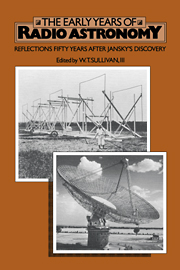Book contents
- Frontmatter
- Contents
- Preface
- THE EARLIEST YEARS
- AUSTRALIA
- ENGLAND
- The origins and early history of Jodrell Bank
- Paraboloids, galaxies and stars: memories of Jodrell Bank
- Early work on radio stars at Cambridge
- The development of aperture synthesis at Cambridge
- THE REST OF THE WORLD
- BROADER REFLECTIONS
- Biographical notes on contributors
- Name index
- Subject index
The development of aperture synthesis at Cambridge
Published online by Cambridge University Press: 05 March 2010
- Frontmatter
- Contents
- Preface
- THE EARLIEST YEARS
- AUSTRALIA
- ENGLAND
- The origins and early history of Jodrell Bank
- Paraboloids, galaxies and stars: memories of Jodrell Bank
- Early work on radio stars at Cambridge
- The development of aperture synthesis at Cambridge
- THE REST OF THE WORLD
- BROADER REFLECTIONS
- Biographical notes on contributors
- Name index
- Subject index
Summary
By the beginning of 1954 the principles of aperture synthesis were fully understood all over the world, but the world of radio astronomy was then very small, and the world I mean, in which radio astronomy was controlled by radio engineers who were learning astronomy, was smaller still. In the Netherlands and in the United States radio astronomy was in the hands of real astronomers, to whom a telescope meant a paraboloidal mirror and nothing else; their contributions were of a different kind. So the little world that understood aperture synthesis consisted of CSIRO Radiophysics Division in Sydney, the English radio astronomers at Cambridge and Manchester, and the French group at Nançay. Furthermore, the Manchester group were preoccupied with building a very large paraboloid indeed, so they were not very interested.
The underlying principles were neatly written down by Bracewell and Roberts (1954). I wrote them down too, but only in my thesis (Scheuer 1954), because Martin Ryle took a severe line, that on engineering topics you shouldn't write mere theory, you should jolly well build the thing first. It took ten years to get from the principles to the first full-scale working instrument of the modern kind: the Cambridge one-mile telescope. I don't think that was because we couldn't make the next mental step to earth rotation synthesis. Pat O'Brien had observed the sun with interferometers along various position angles at various times of day (O'Brien 1953), and I had observed the profile of the Milky Way at such time as it makes a vertical arch over Cambridge, so the fact that the earth turns the interferometer had been forced into our consciousness quite hard enough.
- Type
- Chapter
- Information
- The Early Years of Radio AstronomyReflections Fifty Years after Jansky's Discovery, pp. 249 - 266Publisher: Cambridge University PressPrint publication year: 1984
- 7
- Cited by



